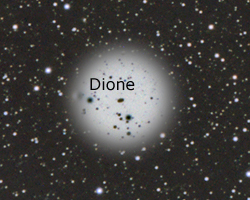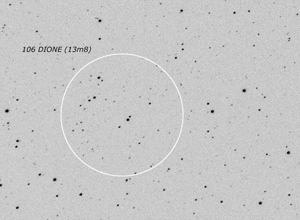 |
CHAMÄLEON + ONJALA OBSERVATORY Solar System | SITEMAP HOME CHAMÄLEON |
|
 |
|||
|
|
|||||||||||
| Comets |
 |
Comet Siding Spring passes Mars at closest
approach Image data: 19.10 2014 — 30 x 30 Seconds, Canon EOS 60 DA Telescope: Zeiss APQ , D = 150 mm, f = 1200 mm Location: Onjala Observatory at Onjala Lodge, Namibia Image processing: Nebulosity, Registar, Photoshop CS5 Load higher resolution image and description of object |
 |
CLAUSBAADER
In the year 2015 we planned to photograph the minor planet (5658) Clausbaader. It has had a high altitude in the evening sky, close to Saturn. The series is intended as a small tribute to Mr. Claus Baader, the founder of Baader Planetarium in Mammendorf, who was one of the leading personalities in the field of amateur astronomy and public education in the last century in Germany. A detailed description and a lot of images we give in our section "Special Project under the headline Minor Planet Clausbaader (5658) |
 |
PAECH In November 2000 one of us was given the great honour and a planetoid was named after him. In October 2011 "9700 Paech" was in the constellation Pisces with a magnitude of about 17. So some CCD r images were taken with the 150mm Zeiss APQ telescope. The observations are put together on a special page. Interested? Then click here (sorry only in german language). |
 |
VESTA, Adorea and
Lilaea The Planetoid Vesta (4, 7m2), taken on 14.09.2018. 6 x 120 seconds with 200mm telephoto lens. Additionally the picture shows the planetoids Adorea (268, 13m9) and Lilaea (213, 13m2). Top left in the picture the planet Saturn. Click the thumbnailto load a large image. Click here to load a large image with object labeling. The photo is part of a "special project" from 2018, in which all 8 planets (including Pluto) were photographed in a short time interval. Interested? Then click here Below are three animations of the first and last images of the series. |
 |
 |
 |
| 4 Vesta - 7m2 | 213 Adorea - 13m9 | 213 Lilaea - 13m2 |
 |
Helio (895) Helio is a - with a diameter of almost 150km - quite large typical main belt asteroid. Its orbital period around the sun is 5.73 years. It was discovered on 11 July 1918 by the Heidelberger astronomer Max Wolf. It was named after the chemical element and noble gas helium. On 26 April 2019 Helio was situated just west of the open star cluster Messier 48 in the constellation Water Serpent. The animation below shows the position of Helio at 1 hour intervals. During this time Helio moved around 30.6 arcseconds. Its brightness at the time was 13m9. « Load large animation (1800pxl) Helio together with Messier 48. |
 |
 |
| The Asteroids Ceres, Dione and
Katyusha In the evening of September 2, 2019 the planetoids Ceres, Dione and Katyusha together with the globular cluster M 80 in the constellation Scorpio were together in the field of view of our Astro Physics refractor EDFS 130mm at f = 850mm. In the same field of view also the small and faint galaxies IC 4596 and IC 4600. The brightnesses of the planetoids this evening were: Ceres (1) 8m8, Dione (106) 13m8 and Katyusha (1900) 17m1. With our ZWO ASI 071 Pro over 60 minutes of short exposures of 300 seconds each were recorded. Click here or on the preview image to load a large image with text labels » More detailed information about Ceres here here, about Dione here and about Katyusha here |
 |
 |
 |
 |
« The trails at an exposure time of 60
minutes: left Ceres, middle Dione and right Katyusha
The 3 animations below show the movement of the planetoids in a time interval of 60 minutes. |
 |
 |
 |
| load large Ceres animation | load large Dione animation | load large Ceres+Katyusha animation |
 |
The Trojan 21000
Orus Orus is an asteroid of the so called Trojan group. Trojans are asteroids orbiting the sun on the orbit of Jupiter. Orus has a position near Jupiter's Lagrange point L4 and thus belongs to the "Greek Group" of Trojans, which precede the planet. Orus has a diameter of about 51 kilometers, a rotation period of 13 hours and 27 minutes, and probably belongs to the class of carbonaceous chondrites. The name Orus comes from the Greek saga Iliad by Homer, which describes the Trojan War. It was discovered only in 1999 by the Japanese amateur astronomer Takao Kobayashi. « Click here the thumbnail to load a large annoted image. |
After determination of the orbital data Orus could be traced on photographs back to 1951, so also plates of the Palomar/Leiden Sky Survey of the couple v. Houten-Groeneveld and Tom Gehrels with the 48" Schmidt telescope. Orbital elements, more information, and an animated orbit of Orus can be found on the Jet Propulsion Laboratory's small-body website .
Image data: Astro Physics 130mm EDFS at f = 850mm, ZWO ASI 071 PRO camera with gain 50, exposure time 450 seconds each.
| The Trojan 3548
Eurybates Eurybates is - like Orus - also an asteroid of the Trojan group. Orus has a position near Jupiter's Lagrange point L4 and thus belongs to the "Greek Group" of the Trojans, which precede the planet. Eurybates is the largest of the Trojans, with a diameter of about 72 kilometers and a rotation period of 8.7 hours. Eurybates was the friend and companion of Odysseus from the Greek myth Iliad by Homer. It was discovered in 1973 during the Palomar/Leiden Sky Survey by the couple v. Houten-Groeneveld and Tom Gehrels with the 48" Schmidt telescope. » Click here the thumbnail to load a large annoted image. |
 |
Image data (Raw images: Dr. H. Michaelis/DLR Berlin): Pentax SDP 105mm f = 670mm, camera QHY 174 M, exposure time 600 seconds each.
 |
 |
 |
 |
 |
 |
 |
| Sun | Moon | Solar System | DeepSky | Widefield | Miscellaneous | Spec. Projects |
